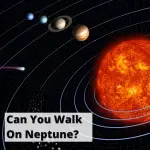Yes, it is possible for a human to walk on Pluto.
In the following article, we’ll explain.
Can You Walk On Pluto? (EXPLAINED)
Introduction To Pluto
Pluto was discovered in the 1930s.
It was first designated as a planet, but got demoted to dwarf planet status in 2006.
We don’t have tons of information about Pluto, but as best as we can tell, we think Pluto has a solid rocky core, and that core is probably surrounded by a thick later of water ice.
The core might be silicate rock, mixed with other metals.
There may also be other kinds of ice around the core in addition to water ice, such as methane ice, and nitrogen ice.
Pluto’s gravity is quite a bit less than Earth’s, about 1/15th. A person who weighs 200lbs on Earth will weigh between 13-14lbs.
To compare, the gravity on the Earth’s moon is 1/6th of that of Earth.
Why Can You Walk On Pluto?
Unlike gas giants Jupiter and Saturn, and ice giants Uranus and Neptune, Pluto’s surface is a solid one.
This means that if humans could get a space ship all the way to Pluto, the ship could land on Pluto.
And, once the ship has landed, humans could exit the ship and stand on the surface of the planet.
Since the gravity is much less than that of Earth, the human spacetraveler would not be risking immediate death as a result of crushing pressure as he would be if he was trying to get to the solid core of Saturn or Jupiter.
However, “walking” on Pluto would probably look more like hopping, bounding, or bouncing around the surface.
The escape velocity on Pluto is not significant, but it is enough to prevent humans walking about from jumping right off the planet into space.
If a person wanted to actually walk on the surface of Pluto, the astronaut would probably need to add a significant amount of weight to his gear in order to keep his feet firmly enough on the surface of the planet to actually walk around.
You’d have to plan your gear to take into account the bouncing and the likelihood of crashing into something or falling.
If you are wearing extremely bulky or restrictive gear (or weight), you might struggle to get yourself back to stable and oriented.
Some winds have been observed on Pluto, but they generally do not come anywhere near to the strength that has been observed on the gas giants and ice giants.
As long as you do your spacewalk when the winds are quiet, you shouldn’t be in danger.
Otherwise, assuming you have gear to handle the freezing cold temperature of Pluto’s surface (around -375 degrees F), and your own air to breathe, you should be able to explore Pluto on foot.
In the end, the temperature would probably be more of a challenge to overcome than the lack of significant gravity.
Did You Know? (Other Facts About Pluto)
Here’s some other cool facts about Pluto you should know about:
- Pluto is about 3.7 billion miles from the sun. To compare, Earth is a paltry 91 million miles from the sun, and Saturn is about 920 million miles from the sun.
- It takes Pluto about 248 Earth years to orbit the sun. To compare, it takes Mars just 687 Earth days, and it takes Mercury only 88 Earth days to make the same trip around.
- Pluto’s orbit around the sun is more like an ellipse than a circle. This means that Pluto is sometimes closer to the sun, then further away. In fact, depending upon where Pluto is in its orbit, it might actually be closer to the sun than its nearest neighbor, Neptune. Pluto’s orbit is probably influenced by the strong forces exhibit by other features of our solar system, including other planets.
- Pluto rotates rather slowly. While it is only 1/6th the size of Earth, it still takes more than 6 Earth days to spin around completely once.
- Pluto has a thin atmosphere, but it seems to be disappearing. It is composed mostly of nitrogen, with a bit of methane and carbon dioxide. Scientists think that as Pluto moves to an area of orbit that is farther away from the sun that the gaseous molecules in the atmosphere are freezing. Presumably, the atmosphere would return as the planet again moves back toward the sun and warms up a bit.
- Pluto has moons of its own, Charon, Hydra, Kerberos, Nix, and Styx. Charon is actually tidally locked in place in its orbit around Pluto. This means that if you were standing on Pluto, Charon would always be in the same place in the sky if you there was enough light bouncing off of it to allow you to see it. Further, it is much closer to the surface of Pluto than Earth’s moon is.
- While scientists have long supposed that the core of Pluto was solid, there is emerging evidence that it may also be molten, like that of Earth. Reason? There is observable evidence on the surface of Pluto of active geological changes, usually not associated with a solid mantle and core.
Wrap Up
Pluto is a fascinating planet, and we look forward to learning more about it as the progress of space exploration continues.
You might also enjoy:







